
Apsara
Encyclopedia
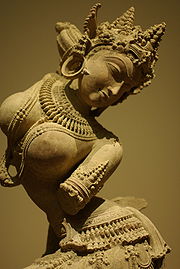
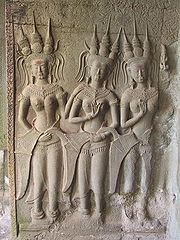
Khmer language
Khmer , or Cambodian, is the language of the Khmer people and the official language of Cambodia. It is the second most widely spoken Austroasiatic language , with speakers in the tens of millions. Khmer has been considerably influenced by Sanskrit and Pali, especially in the royal and religious...
, Accharā (Pāli
Páli
- External links :* *...
) or A Bố Sa La Tư (Vietnamese
Vietnamese language
Vietnamese is the national and official language of Vietnam. It is the mother tongue of 86% of Vietnam's population, and of about three million overseas Vietnamese. It is also spoken as a second language by many ethnic minorities of Vietnam...
), Bidadari (Indonesian
Indonesian language
Indonesian is the official language of Indonesia. Indonesian is a normative form of the Riau Islands dialect of Malay, an Austronesian language which has been used as a lingua franca in the Indonesian archipelago for centuries....
& Malay
Malay language
Malay is a major language of the Austronesian family. It is the official language of Malaysia , Indonesia , Brunei and Singapore...
), Biradali (Tausug
Tausug language
Tausūg is a language spoken in the province of Sulu in the Philippines, in Malaysia, and in Indonesia by the Tausūg people....
), Widodari (Javanese
Javanese language
Javanese language is the language of the Javanese people from the central and eastern parts of the island of Java, in Indonesia. In addition, there are also some pockets of Javanese speakers in the northern coast of western Java...
) and Apson , is a female spirit of the clouds and waters in Hindu
Hindu mythology
Hindu religious literature is the large body of traditional narratives related to Hinduism, notably as contained in Sanskrit literature, such as the Sanskrit epics and the Puranas. As such, it is a subset of Nepali and Indian culture...
and Buddhist mythology
Buddhist mythology
Buddhist mythology operates within the Buddhist belief system. It is a relatively broad mythology, as it was adopted and influenced by several diverse cultures such as Gandhara which was the capital of Bactria. Later on, it also came to incorporate aspects from countries such as China and Japan...
. English translations of the word "Apsara" include "nymph
Nymph
A nymph in Greek mythology is a female minor nature deity typically associated with a particular location or landform. Different from gods, nymphs are generally regarded as divine spirits who animate nature, and are usually depicted as beautiful, young nubile maidens who love to dance and sing;...
," "celestial nymph," and "celestial maiden."
Apsaras are beautiful, supernatural female beings. They are youthful and elegant, and superb in the art of dancing. They are often the wives of the Gandharva
Gandharva
Gandharva is a name used for distinct mythological beings in Hinduism and Buddhism; it is also a term for skilled singers in Indian classical music.-In Hinduism:...
s, the court musicians of Indra
Indra
' or is the King of the demi-gods or Devas and Lord of Heaven or Svargaloka in Hindu mythology. He is also the God of War, Storms, and Rainfall.Indra is one of the chief deities in the Rigveda...
. They dance to the music made by the Gandharvas, usually in the palaces of the gods, entertain and sometimes seduce gods and men. As caretakers of fallen heroes, they may be compared to the valkyries of Norse mythology
Norse mythology
Norse mythology, a subset of Germanic mythology, is the overall term for the myths, legends and beliefs about supernatural beings of Norse pagans. It flourished prior to the Christianization of Scandinavia, during the Early Middle Ages, and passed into Nordic folklore, with some aspects surviving...
. As etherial beings who inhabit the skies, and are often depicted taking flight
Flight
Flight is the process by which an object moves either through an atmosphere or beyond it by generating lift or propulsive thrust, or aerostatically using buoyancy, or by simple ballistic movement....
, or at service of a god, they may be compared to angel
Angel
Angels are mythical beings often depicted as messengers of God in the Hebrew and Christian Bibles along with the Quran. The English word angel is derived from the Greek ἄγγελος, a translation of in the Hebrew Bible ; a similar term, ملائكة , is used in the Qur'an...
s.
Apsaras are said to be able to change their shape at will, and rule over the fortunes
Luck
Luck or fortuity is good fortune which occurs beyond one's control, without regard to one's will, intention, or desired result. There are at least two senses people usually mean when they use the term, the prescriptive sense and the descriptive sense...
of gaming and gambling. Urvasi
Urvasi
Urvashi Urvashi Urvashi in Hindu legend. She was a celestial maiden in Indra's court and was considered the most beautiful of all the Apsaras....
, Menaka
Menaka
In Hindu mythology, Menaka is considered one of the most beautiful of the heavenly Apsaras.She was sent by Indra, the king of the Devas, to break the severe penance undertaken by Vishwamitra. She successfully incited Vishwamitra's lust and passion when he saw her swimming naked in a lake near a...
, Rambha and Tilottama
Tilottama
Tilottama is an Apsara described in Hindu mythology. "Tila" is the Sanskrit word for sesame seed or a bit and "uttama" means better or higher...
are the most famous among them. Apsaras are sometimes compared to the muses of ancient Greece, with each of the 26 Apsaras at Indra's court representing a distinct aspect of the performing arts. Apsaras are associated with water; thus, they may be compared to the nymphs, dryads and naiads of ancient Greece. They are associated with fertility rite
Fertility rite
Fertility rites are religious rituals that reenact, either actually or symbolically, sexual acts and/or reproductive processes: 'sexual intoxication is a typical component of the...rites of the various functional gods who control reproduction, whether of man, beast, cattle, or grains of seed'..They...
s.
There are two types of Apsaras; Laukika (worldly), of whom thirty-four are specified, and Daivika (divine), of which there are ten.
Apsaras in literature
Rig Veda
The Rig Veda tells of an Apsara who is the wife of GandharvaGandharva
Gandharva is a name used for distinct mythological beings in Hinduism and Buddhism; it is also a term for skilled singers in Indian classical music.-In Hinduism:...
; however, the Rig Veda also seems to allow for the existence of more than one Apsara. The only Apsara specifically named is Urvashi. An entire hymn deals with the colloquy
Colloquy (religious)
A religious colloquy is a meeting to settle differences of doctrine or dogma, also called a colloquium , as in the historical Colloquy at Poissy, and like the legal colloquy, most often with a certain degree of judging involved...
between Urvashi and her mortal lover Pururavas
Pururavas
Pururavas was the first king of the Aila dynasty or the Somavamsha. According to the Vedas, he is a mythological entity associated with the Surya and Usha , and is believed to resided in the middle region of the cosmos. The Rig Veda states that he was a son of Ila and was a pious king...
. Later Hindu scriptures allow for the existence of numerous Apsaras, who act as the handmaidens of Indra
Indra
' or is the King of the demi-gods or Devas and Lord of Heaven or Svargaloka in Hindu mythology. He is also the God of War, Storms, and Rainfall.Indra is one of the chief deities in the Rigveda...
or as dancers at his celestial court.
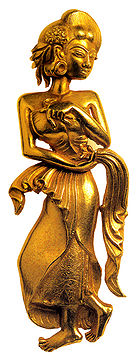
Apsaras in Malay culture
The term 'Bidadari' is a Malay word that comes from a tale of the Quran, in which God stated that the 'forbidden pearls' of heaven are for those men who have resisted temptation and borne life's trials. Islam spread in the Malay archipelago when Arabic traders came to trade spices with the Malays; at that time, Hinduism formed the basis of the Malay culture, but syncretismSyncretism
Syncretism is the combining of different beliefs, often while melding practices of various schools of thought. The term means "combining", but see below for the origin of the word...
with the Islamic religion and culture spawned the idea of a Bidadari. It is usually seen as a prized offer to those who lived a lifestyle in service to and pleasing to God; after death, the Bidadari was the man's wife or wives, depending on what type of person he was. The worthiness of a man who was offered Bidadari depended upon his holiness: how often he prayed, how much he turned away from the 'outside world', and how little he heeded worldly desires.
Mahabharata
In many of the stories related in the MahabharataMahabharata
The Mahabharata is one of the two major Sanskrit epics of ancient India and Nepal, the other being the Ramayana. The epic is part of itihasa....
, Apsaras appear in important supporting roles. The epic contains several lists of the principal Apsaras, which lists are not always identical. Here is one such list, together with a description of how the celestial dancers appeared to the residents and guests at the court of the gods:
Ghritachi and Menaka and Rambha and Purvachitti and Swayamprabha and Urvashi and Misrakeshi and Dandagauri and Varuthini and Gopali and Sahajanya and Kumbhayoni and Prajagara and Chitrasena and Chitralekha and Saha and Madhuraswana, these and others by thousands, possessed of eyes like lotus leaves, who were employed in enticing the hearts of persons practising rigid austerities, danced there. And possessing slim waists and fair large hips, they began to perform various evolutions, shaking their deep bosoms, and casting their glances around, and exhibiting other attractive attitudes capable of stealing the hearts and resolutions and minds of the spectators.
Exploits of individual Apsaras
The Mahabharata documents the exploits of individual Apsaras, such as TilottamaTilottama
Tilottama is an Apsara described in Hindu mythology. "Tila" is the Sanskrit word for sesame seed or a bit and "uttama" means better or higher...
, who rescued the world from the rampaging asura
Asura
-In Hinduism:In Hinduism, the Asuras constitute a group of power-seeking deities, sometimes considered sinful and materialistic. The Daityas and Danavas were combinedly known as Asuras. The Asura were opposed to the Devas. Both groups are children of Kasyapa...
brothers Sunda
Sunda (asura)
A mythological character from the great epic Mahabharata, Sunda was an asura prince and the brother of Upasunda. Their father was Jambha. The brothers grew up to be very powerful and were always of one mind. Together, they embarked on a campaign of world domination that began with a program of...
and Upasunda
Upasunda
A mythological character from the great epic Mahabharata, Upasunda was an asura prince and the brother of Sunda. The brothers grew up to be very powerful and were always of one mind. Together, they embarked on a campaign of world domination that began with a program of extreme asceticism in the...
, and Urvashi, who attempted to seduce the hero Arjuna
Arjuna
Arjuna in Indian mythology is the greatest warrior on earth and is one of the Pandavas, the heroes of the Hindu epic Mahābhārata. Arjuna, whose name means 'bright', 'shining', 'white' or 'silver' Arjuna (Devanagari: अर्जुन, Thai: อรชุน, Orachun, Tamil: Arjunan, Indonesian and Javanese: Harjuna,...
.
The Nymph and the Sage
A story type or theme appearing over and over again in the Mahabharata is that of an Apsara sent to distract a sage or spiritual master from his ascetic practices. One story embodying this theme is that recounted by the epic heroine ShakuntalaShakuntala
In Hindu mythology Shakuntala is the wife of Dushyanta and the mother of Emperor Bharata. Her story is told in the Mahabharata and dramatized by Kalidasa in his play Abhijñānaśākuntalam .-Etymology:Rishi Kanva found her in forest as a baby surrounded by Shakunta birds...
to explain her own parentage. Once upon a time, the sage Viswamitra generated such intense energy by means of his asceticism that Indra
Indra
' or is the King of the demi-gods or Devas and Lord of Heaven or Svargaloka in Hindu mythology. He is also the God of War, Storms, and Rainfall.Indra is one of the chief deities in the Rigveda...
himself became fearful. Deciding that the sage would have to be distracted from his penances, he sent the Apsara Menaka
Menaka
In Hindu mythology, Menaka is considered one of the most beautiful of the heavenly Apsaras.She was sent by Indra, the king of the Devas, to break the severe penance undertaken by Vishwamitra. She successfully incited Vishwamitra's lust and passion when he saw her swimming naked in a lake near a...
to work her charms. Menaka
Menaka
In Hindu mythology, Menaka is considered one of the most beautiful of the heavenly Apsaras.She was sent by Indra, the king of the Devas, to break the severe penance undertaken by Vishwamitra. She successfully incited Vishwamitra's lust and passion when he saw her swimming naked in a lake near a...
trembled at the thought of angering such a powerful ascetic, but she obeyed the god's order. As she approached Viswamitra, the wind god Vayu
Vayu
Vāyu is a primary Hindu deity, the Lord of the winds, the father of Bhima and the spiritual father of Lord Hanuman...
tore away her garments. Seeing her thus disrobed, the sage abandoned himself to lust. Nymph and sage engaged in sex for some time, during which Viswamitra's asceticism was put on hold. As a consequence, Menaka gave birth to a daughter, whom she abandoned on the banks of a river. That daughter was Shakuntala herself, the narrator of the story.
Natya Shastra
Natya ShastraNatya Shastra
The Natya Shastra is an ancient Indian treatise on the performing arts, encompassing theatre, dance and music. It was written during the period between 200 BC and 200 AD in classical India and is traditionally attributed to the Sage Bharata.The Natya Shastra is incredibly wide in its scope...
, the principle work of dramatic theory for Sanskrit drama, lists the following apsaras: Manjukesi, Sukesi, Misrakesi, Sulochana, Saudamini, Devadatta, Devasena, Manorama, Sudati, Sundari, Vigagdha, Vividha, Budha, Sumala, Santati, Sunanda, Sumukhi, Magadhi, Arjuni, Sarala, Kerala, Dhrti, Nanda, Supuskala, Supuspamala and Kalabha.
In the visual arts
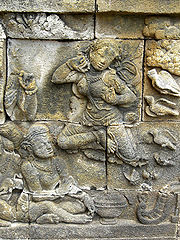
Apsaras in the art of ancient Java and Bali, Indonesia
Images of Apsaras are found in several temples of ancient JavaJava
Java is an island of Indonesia. With a population of 135 million , it is the world's most populous island, and one of the most densely populated regions in the world. It is home to 60% of Indonesia's population. The Indonesian capital city, Jakarta, is in west Java...
dating from the era of the Sailendra
Sailendra
Sailendra is the name of an influential Indonesian dynasty that emerged in 8th century Java.The Sailendras were active promoters of Mahayana Buddhism and covered the Kedu Plain of Central Java with Buddhist monuments, including the world famous Borobudur.The Sailendras are considered to be a...
dynasty to that of the Majapahit empire. Usually they are not found as decorative motifs but as integral parts of a story in bas-relief, as for example at Borobudur
Borobudur
Borobudur, or Barabudur, is a 9th-century Mahayana Buddhist monument near Magelang, Central Java, Indonesia. The monument comprises six square platforms topped by three circular platforms, and is decorated with 2,672 relief panels and 504 Buddha statues...
, Mendut
Mendut
Mendut is a ninth century Buddhist temple, located in Mendut village, Mungkid sub-district, Magelang Regency, Central Java, Indonesia. The temple is located about three kilometres east from Borobudur. Mendut, Borobudur and Pawon, all of which are Buddhist temples, are located in one straight line...
, Prambanan
Prambanan
Prambanan is a ninth century Hindu temple compound in Central Java, Indonesia, dedicated to the Trimurti, the expression of God as the Creator , the Sustainer and the Destroyer...
, Plaosan
Candi Plaosan
Candi Plaosan, also known as the 'Plaosan Complex', is one of the Buddhist temples located in Bugisan village, Prambanan district, Central Java, Indonesia....
, and Penataran
Penataran Temple
Penataran or Panataran is the largest Hindu temple complex in East Java, Indonesia, located roughly 10 km north of Blitar. Believed to have been under construction from the 12th Century to the 15th Century, the temple played a significant role in the Majapahit Kingdom, especially under King Hayam...
. At Borobudur apsaras are depicted as divinely beautiful celestial maidens, pictured either in standing or in flying positions, usually holding lotus blossoms, spreading flower petals, or waving celestial clothes as if they were wings enabling them to fly. The temple of Mendut
Mendut
Mendut is a ninth century Buddhist temple, located in Mendut village, Mungkid sub-district, Magelang Regency, Central Java, Indonesia. The temple is located about three kilometres east from Borobudur. Mendut, Borobudur and Pawon, all of which are Buddhist temples, are located in one straight line...
near Borobudur depicted groups of devatas
Devatas
Deva is the Hindu term for deity; devatas , are a kind of smaller more focused devas, the equivalent of guardian spirits or guardian angels. The term "devata" also means devas . They are male and female devata...
, divine beings flying in heaven, which included apsaras.
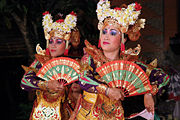
Indra
' or is the King of the demi-gods or Devas and Lord of Heaven or Svargaloka in Hindu mythology. He is also the God of War, Storms, and Rainfall.Indra is one of the chief deities in the Rigveda...
's heaven (Kaéndran). They are well known for their special task: being sent to earth by Indra to seduce ascetics who by their severe practices may become more powerful than the gods. This theme occurs frequently in Javanese traditions, including the "Kakawin Arjunawiwaha", written by mpu Kanwa in 1030 during the reign of king Airlangga
Airlangga
Airlangga was the only raja of the Kingdom of Kahuripan, which was built out of the rubble of the Kingdom of Medang after the Srivijaya invasion...
. The story tells that Arjuna
Arjuna
Arjuna in Indian mythology is the greatest warrior on earth and is one of the Pandavas, the heroes of the Hindu epic Mahābhārata. Arjuna, whose name means 'bright', 'shining', 'white' or 'silver' Arjuna (Devanagari: अर्जुन, Thai: อรชุน, Orachun, Tamil: Arjunan, Indonesian and Javanese: Harjuna,...
, in order to defeat the giant Niwatakawaca, engaged in meditation and asceticism, whereupon Indra sent apsaras to seduce him. Arjuna, however, managed to conquer his lust and then to win the ultimate weapons from the gods to defeat the giant.
Later in the Java
Java
Java is an island of Indonesia. With a population of 135 million , it is the world's most populous island, and one of the most densely populated regions in the world. It is home to 60% of Indonesia's population. The Indonesian capital city, Jakarta, is in west Java...
nese tradition the apsara was also called Hapsari, also known as Widodari (from sanskrit
Sanskrit
Sanskrit , is a historical Indo-Aryan language and the primary liturgical language of Hinduism, Jainism and Buddhism.Buddhism: besides Pali, see Buddhist Hybrid Sanskrit Today, it is listed as one of the 22 scheduled languages of India and is an official language of the state of Uttarakhand...
word Vidhyadhari, vidhya: knowledge, dharya: having, bearer, or bringer), and finally known as Bidadari in the modern Indonesian language
Indonesian language
Indonesian is the official language of Indonesia. Indonesian is a normative form of the Riau Islands dialect of Malay, an Austronesian language which has been used as a lingua franca in the Indonesian archipelago for centuries....
(the same form of the word is now present in the Malay language
Malay language
Malay is a major language of the Austronesian family. It is the official language of Malaysia , Indonesia , Brunei and Singapore...
, as well). The Javanese Hindu-Buddhist tradition also influenced Bali
Bali
Bali is an Indonesian island located in the westernmost end of the Lesser Sunda Islands, lying between Java to the west and Lombok to the east...
. In Balinese dance the theme of celestial maidens often occurred. Dances such as Sanghyang Dedari and Legong depicted divine maidens in their own way. In the court of Mataram Sultanate
Mataram Sultanate
The Sultanate of Mataram was the last major independent Javanese empire on Java before the island was colonized by the Dutch. It was the dominant political force in interior Central Java from the late 16th century until the beginning of the 18th century....
the tradition of depicting heavenly maidens in dances still alive and well. The Javanese court dances of Bedhaya
Bedhaya
The bedhaya is a sacred ritualized dance of Java, Indonesia, associated with the royal palaces of Yogyakarta and Surakarta...
portray apsaras.
Apsaras in the art and architecture of Cambodia
Apsaras represent an important motif in the stone bas-reliefs of the AngkorAngkor
Angkor is a region of Cambodia that served as the seat of the Khmer Empire, which flourished from approximately the 9th to 15th centuries. The word Angkor is derived from the Sanskrit nagara , meaning "city"...
ian temples in Cambodia
Cambodia
Cambodia , officially known as the Kingdom of Cambodia, is a country located in the southern portion of the Indochina Peninsula in Southeast Asia...
(8th-13th century AD), however all female images are not considered to be apsaras. In harmony with the Indian association of dance with apsaras, Khmer female figures that are dancing or are poised to dance are considered apsaras; female figures, depicted individually or in groups, who are standing still and facing forward in the manner of temple guardians or custodians are called devatas.
Angkor Wat
Angkor Wat
Angkor Wat is a temple complex at Angkor, Cambodia, built for the king Suryavarman II in the early 12th century as his state temple and capital city. As the best-preserved temple at the site, it is the only one to have remained a significant religious centre since its foundation – first Hindu,...
, the largest Angkorian temple built (1116-1150 AD), features both apsaras and devata, however the devata type are the most numerous with more than 1,796 in the present research inventory. Angkor Wat architects employed small apsara images (30–40 cm as seen at left) as decorative motifs on pillars and walls. They incorporated larger devata images (all full-body portraits measuring approximately 95–110 cm) more prominently at every level of the temple from the entry pavilion to the tops of the high towers. In 1927, Sappho Marchal published a study cataloging the remarkable diversity of their hair, headdresses, garments, stance, jewelry and decorative flowers, which Marchal concluded were based on actual practices of the Angkor period. Some devata appear with arms around each other and seem to be greeting the viewer. “The devatas seem to epitomize all the elements of a refined elegance,” wrote Marchal.

Khmer classical dance
Khmer classical danceKhmer classical dance
The Royal Ballet of Cambodia is a form of performing arts established in the royal courts of Cambodia for the purpose of entertainment as well as ceremonial propitiation...
, the indigenous ballet-like performance art of Cambodia, is frequently called "Apsara Dance".
Apsaras in the art of Champa
Apsaras were also an important motif in the art of ChampaArt of Champa
Champa was an Indic civilization that flourished along the coasts of what is now central and southern Vietnam for roughly a one thousand year period between 500 AD and 1500 AD. The original Chams were probably colonists from the Indonesian islands, who adopted as their principal vocations those of...
, medieval Angkor
Angkor
Angkor is a region of Cambodia that served as the seat of the Khmer Empire, which flourished from approximately the 9th to 15th centuries. The word Angkor is derived from the Sanskrit nagara , meaning "city"...
's neighbor to the east along the coast of what is now central Vietnam. Especially noteworthy are the depictions of apsaras in the Tra Kieu Style of Cham art, a style which flourished in the 10th and 11th centuries A.D.
Apsaras in the cave art of China
Apsaras are often depicted as flying figures in the mural paintings and sculptures of Buddhist cave sites in China such as in the Mogao CavesMogao Caves
The Mogao Caves or Mogao Grottoes , also known as the Caves of the Thousand Buddhas , form a system of 492 temples southeast of the center of Dunhuang, an oasis strategically located at a religious and cultural crossroads on the Silk Road, in Gansu province, China...
, Yulin Caves, and the Yungang
Yungang Grottoes
The Yungang Grottoes are ancient Chinese Buddhist temple grottoes near the city of Datong in the province of Shanxi. They are excellent examples of rock-cut architecture and one of the three most famous ancient Buddhist sculptural sites of China...
and Longmen Grottoes
Longmen Grottoes
The Longmen Grottoes or Longmen Caves are one of the finest examples of Chinese Buddhist art. Housing tens of thousands of statues of Buddha and his disciples, they are located south of present day Luòyáng in Hénán province, Peoples Republic of China...
. They may also be depicted as dancers or musicians. They may be referred to as feitian in Chinese.
See also
- AngelAngelAngels are mythical beings often depicted as messengers of God in the Hebrew and Christian Bibles along with the Quran. The English word angel is derived from the Greek ἄγγελος, a translation of in the Hebrew Bible ; a similar term, ملائكة , is used in the Qur'an...
- Angkor WatAngkor WatAngkor Wat is a temple complex at Angkor, Cambodia, built for the king Suryavarman II in the early 12th century as his state temple and capital city. As the best-preserved temple at the site, it is the only one to have remained a significant religious centre since its foundation – first Hindu,...
- Architecture of CambodiaArchitecture of CambodiaThe period of Angkor is the period from approximately the latter half of the 8th century AD to the first half of the 15th century. If precise dates are required, the beginning may be set in 802 AD, when the founder of the Khmer Empire , Jayavarman II pronounced himself universal monarch and...
- Art of ChampaArt of ChampaChampa was an Indic civilization that flourished along the coasts of what is now central and southern Vietnam for roughly a one thousand year period between 500 AD and 1500 AD. The original Chams were probably colonists from the Indonesian islands, who adopted as their principal vocations those of...
- DakiniDakiniA dakini is a tantric deity described as a female embodiment of enlightened energy. In the Tibetan language, dakini is rendered khandroma which means 'she who traverses the sky' or 'she who moves in space'. Sometimes the term is translated poetically as 'sky dancer' or 'sky walker'. The dakini, in...
- Devata
- ElfElfAn elf is a being of Germanic mythology. The elves were originally thought of as a race of divine beings endowed with magical powers, which they use both for the benefit and the injury of mankind...
- Ethereal beingEthereal beingEthereal beings, according to some belief systems and occult theories, are mystic entities that usually are not made of ordinary matter. Despite the fact that they are believed to be essentially incorporeal, they do interact in physical shapes with the material universe and travel between the...
- FairyFairyA fairy is a type of mythical being or legendary creature, a form of spirit, often described as metaphysical, supernatural or preternatural.Fairies resemble various beings of other mythologies, though even folklore that uses the term...
- GandharvaGandharvaGandharva is a name used for distinct mythological beings in Hinduism and Buddhism; it is also a term for skilled singers in Indian classical music.-In Hinduism:...
- Celestial male companions of the asparas - HouriHouriIn Islam, the ḥūr or ḥūrīyah are commonly translated as " companions of equal age ", "lovely eyed", of "modest gaze", "pure beings" or "companions pure" of paradise, denoting humans and jinn who enter paradise after being recreated anew in the hereafter...
- NymphNymphA nymph in Greek mythology is a female minor nature deity typically associated with a particular location or landform. Different from gods, nymphs are generally regarded as divine spirits who animate nature, and are usually depicted as beautiful, young nubile maidens who love to dance and sing;...
- TenninTenninTennin , which may include tenshi , ten no tsukai and the specifically female tennyo are spiritual beings found in Japanese Buddhism that are similar to western angels, nymphs or fairies...
, a Japanese development of Indian apsaras - VishnuVishnuVishnu is the Supreme god in the Vaishnavite tradition of Hinduism. Smarta followers of Adi Shankara, among others, venerate Vishnu as one of the five primary forms of God....
- YakshiniYakshiniYakshinis are mythical beings of Hindu, Buddhist, and Jain mythology.-Description:A yakshini is the female counterpart of the male yaksha, and they both attend on Kubera , the Hindu god of wealth who rules in the mythical Himalayan kingdom of Alaka. They both look after treasure hidden in the...
External links
- Chinese Apsaras depicted in Dunhuang Caves
- Comparison of Khmer Apsaras and Devata
- Costumes and Ornaments after the Devata of Angkor Wat by Sappho Marchal - Book review
- Indian Devata at Rajarani Temple in Orissa
- Japanese traditions of celestial maidens Tennin (apsara), Hiten (flying apsara), Tennyo (celestial maiden) & Karyobinga (bird body with angel head)
- Rice Goddesses of Indonesia, Cambodia and Thailand
- A beautiful person, imaged as an Aspara song

